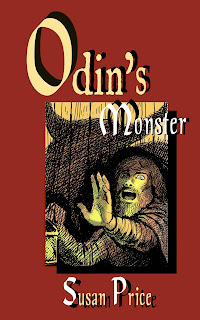 |
| Scotland's top-knot |
The men described her as being brown with rough skin, nine meters (thirty feet) long and having three dorsal humps. They said her head was thirty centimetres (a foot) wide and she held it forty-six centimetres (18 inches) out of the water— until they so rudely interrupted her.
The most recent sighting of Morag was in 2013, by two holiday-makers, who claimed to have seen her three times in two days. If I’m lucky enough to meet her, I shan’t offer her violence or even take her picture— I shall try to interest her in a copy of my Odin’s Monster. My monster isn’t one of Morag’s relatives— though perhaps I should consider writing about one of them. I don’t really know why I haven’t written about a kelpie that transforms itself into a long-backed horse, lures people into riding it and then carries them into deep, cold water and eats them. The legend has definite appeal. But so many monsters, so little time…
 |
| Odin's Monster by Susan Price |
A 'sending' was created by a witch or wizard in a bad mood. At its simplest, the witch or wizard murdered someone, in order to enslave their ghost and ‘send’ it against whoever it was they had a grudge against. Hence the name, ‘sending.’ I used this idea again, in another book, ‘The Ghost Wife.’ Once created, a sending like this could plague a whole family for generations.
The sending or monster in Odin’s Monster, is a kind of super-sending. It’s the dead body of a bull that’s stuffed full of other ghosts— of a man, a woman, a child, an eagle, a bear and others. The monster can appear as any of the ghosts trapped inside it. It can fly like an eagle, roar like a bear, speak with a woman’s voice. In the original legend, Thorgeir is a kind of
 |
| The Ghost Wife |
Instead of tormenting a woman, I have my wizard, Kveldulf Witch, torment a story-teller named Thord Cat. He wants Thord Cat to tell the story of his life, of all his murders and double-dealings, of which he's very proud.
But Thord Cat dislikes the witch and refuses the commission. (The pay's rotten anyway.) Appalled by this cheek, Kveldulf calls on his god, Odin, to help him in creating the monster and he sends it against Thord Cat, to try and force him to do what Kveldulf wants. Every time the Sending arrives at the farmstead in one of its guises, it demands that Thord Cat tell its master’s story. On ‘the third time of asking’, if he refuses, it will kill him.
This story for 8 to 11 year olds was first published by A & C Black in 1986, so long ago that I can't believe it. Over the years I’ve had a lot of fun reading the story aloud to children in schools. I still do. It never fails to have them leaning forward in their seats, with open mouths and wide eyes. After Thord Cat’s second refusal, the sending, in its woman shape, says, “Next time I come horned.” I always break off there and say, “If you want to know how it ends, you must read the rest yourselves.”
This usually brings on groans and pleas for just a hint of how it ends, a clue… Teachers have sometimes had children write their own ending for the story before they read it to them.
 |
| The Wolf's Footprint by Susan Price |
I put together the cover of Odin's Monster, using one of Andrew’s illustrations. The cover’s okay, but I will probably tweak it a little, now I’ve held an actual copy in my hand. I have a couple of other back-list books written for a similar age-group, which I aim re-issue this year.
In the meantime, I’ve just heard that Kate Stilitz’s brilliant musical version of The Wolf’s Footprint is to be staged again, at Tiverton Primary in London— and I shall be going to see it. Looking forward to that enormously.
 | |||||
| The Wolf Pack (in Kate Stilitz's production) |

Odin's Monster
The Wolf's Footprint

No comments:
Post a Comment